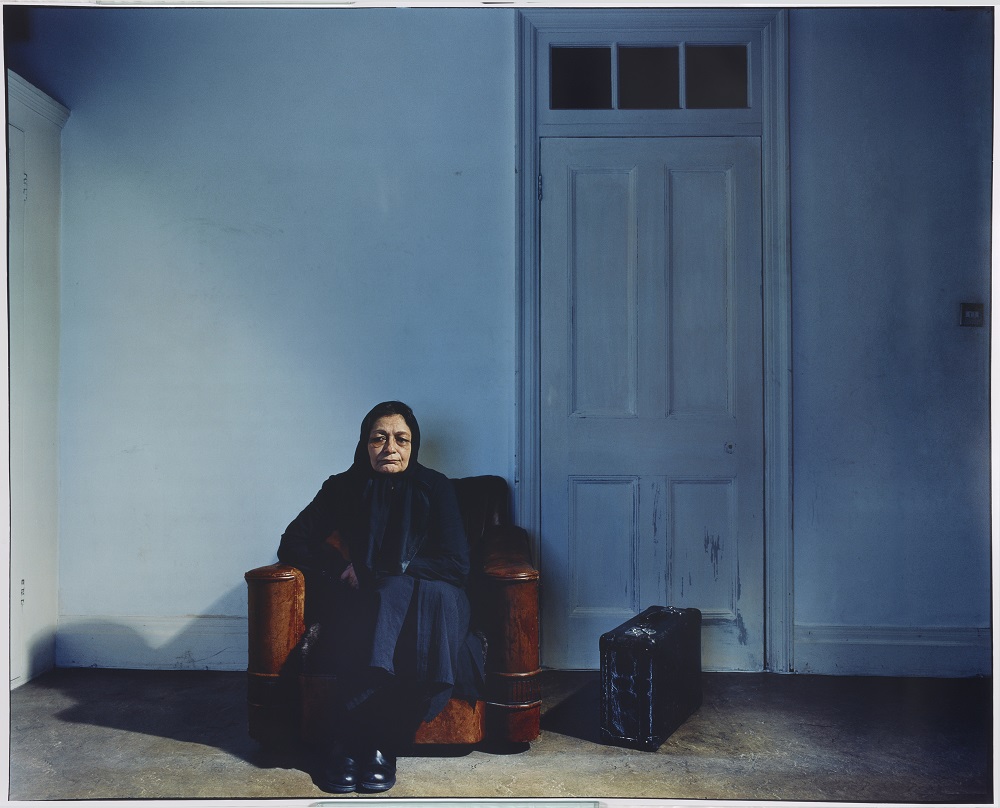By Sheila Wickouski

Witness 1979 By Hengameh Golestan 
A Long Wait By Mitra Tabrizian
Set against the contrasting background of urban Tehran and the natural landscape, Somayeh, by Newsha Tavakolian, is an almost life-sized looped projection. Somayeh stands amid dead tree branches, a gentle wind blows her blue headscarf and the clear plastic garbage bags caught in fallen tree limbs. She is unblinking, enveloped by the branches, but not swallowed by them. Far from being entrapped by upheaval and war, she is resolute in defining her life. Tavakolian has further recorded this in the series Blank Pages of an Iranian Photo Album, which follows Somayeh’s daily life as a teacher of English in an all girls school.
Persistence in the face of personal and political realities, is a theme shared by the artists in offering a female perspective from the beginning of the Iranian Revolution to the present.
One of the few photographers to document the protests of the 1979 Islamic Revolution, when women were ordered to wear the chador or veil in public, Hengameh Golestan created the series Witness, a collection of untitled works of unveiled women. She herself is part of the crowd, not an outside onlooker, as she shares their short lived optimism in the early months of the revolution.
Juxtaposing before and after the revolution, Shadafarin Ghadirian uses themes from 19th-century Iranian photography to dress post-revolution women in historical clothing. They are posed with ordinary objects from contemporary life—a soda can, a newspaper, a bicycle—each with a subtle meaning that accentuates the tension between tradition and modernity in post-revolutionary Iran.
Going back to the early 20th century, Malekeh Nayiny re-creates her childhood in Iran before she left for France in 1980. In Observation, digital alterations of photos of her family is an intimate biography of her parents and a personal memorial.
Works by Mitra Tabrizian and Gohar Dashti are placed together for dramatic effect. Both reference common symbols, like the suitcase, which embodies memory, identity and inner conflicts. Both create their own definitions of what it means to be Iranian, either within the country or outside of it.
Dashti, who works in Iran, focuses on those caught in physical and emotional limbo. One work shows a line of people in a field, each with suitcases but going nowhere. Her portrait of a mother and child with a bloody dead fish from the series Slow Decay, or the line of eleven women clad in black in Iran, are about those who remained in Iran.
Tabrizian, based in London, portrays Iranian emigres who reluctantly left after the revolution. In A Long Wait from her series, Border, a woman sits in a chair in an otherwise empty room with a suitcase posed between her and a door. It is unclear how long has she been there, or even if she’s coming or going.The work evokes an emotional response for her suffering, even as she conveys strength.
Two works stand out from the portraitures. From Dashti’s series, Home, are the views of the inside of houses, devoid of humans and overflowing with plants. What at first seems to be a digital creation, are actually rooms filled to the brim with vegetation by the artist. That natural life thrives even in the most abandoned of places, conveys the message of the persistence of life in times of political and social turmoil.
Whether the portraits were recreated digitally, staged or taken in real life, what they share in common as artworks is to present the authenticity of the subjects in the complex history of their time.
This exhibit is only part of the experience. The Sackler will host other events, including a program about women’s voices in Persian poetry, which will be held in late October, and feature renowned translator of Persian poetry Dick Davis, as well as the author Azar Nafisi. The Iranian Film Festival will take place again next year and the gallery will be open until February 9, 2020.

